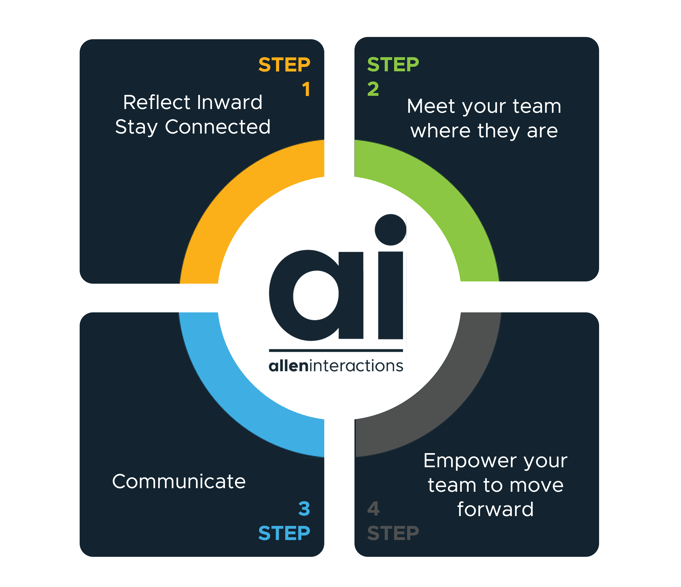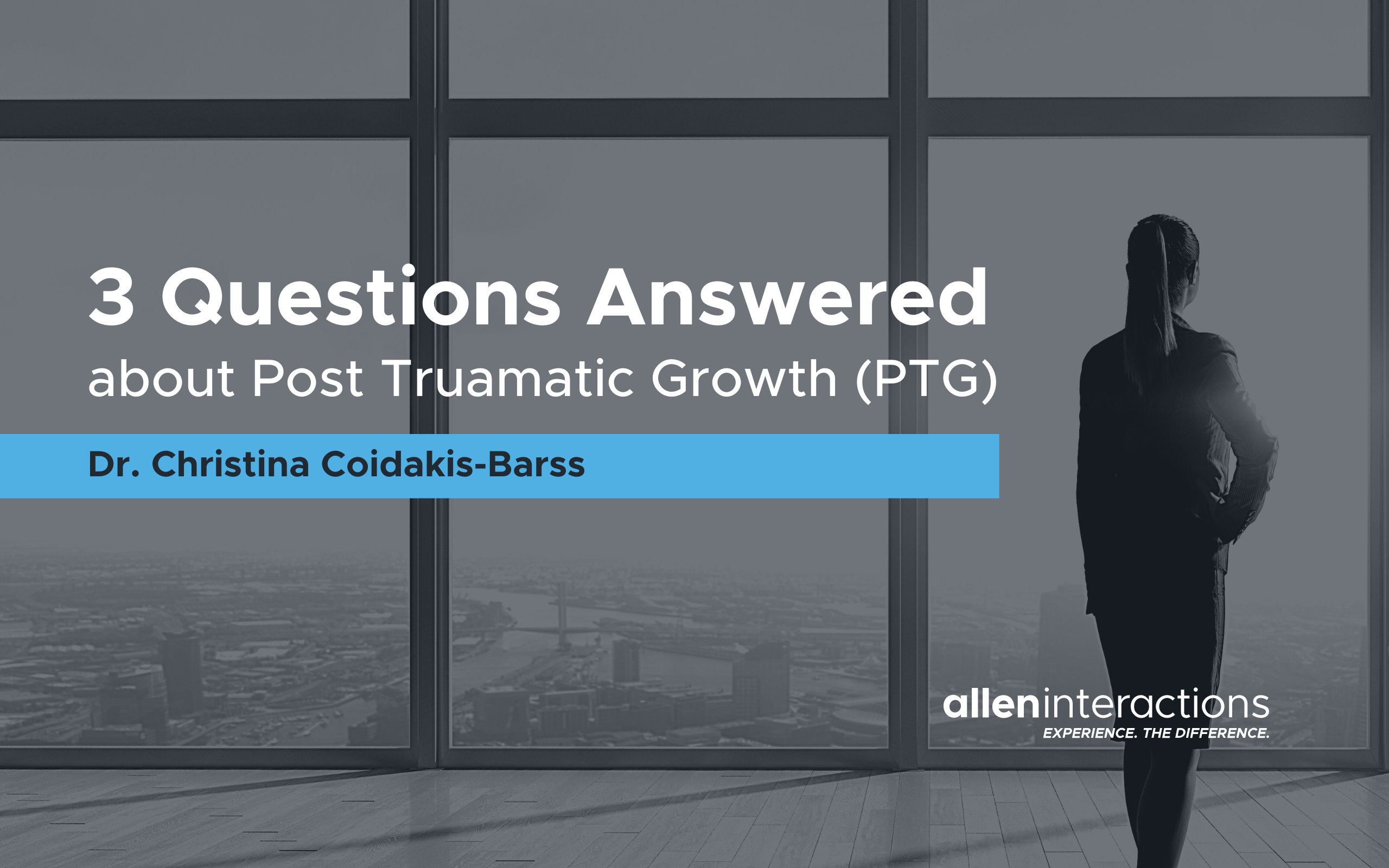Introduction
In mid tsunami of fear and anger, how do leaders bring about calmer waters? Before the many crises we are experiencing today, the leadership qualities of psychological safety, empathy, compassion, and inspiration were coveted. Yet during crisis, this narrative was quickly sidelined by our organizations' need to survive the chaos. Overwhelmed feelings of shock, denial, anger, and depression fill everyone's hearts and minds. In a desire to protect and defend our organizations, we instinctively shift to an authoritative control mindset. Our hope is to bring stability in an unstable world, yet the incessant stress and trauma we and others suffer makes it difficult to see the light.
Looking within, we as leaders are the light when we rise to calm the waters and lead our teams to Post Traumatic Growth.
“There is a delicate balance between being a beacon of hope and a floodlight of authoritarian deafness.” – Dr. Christina Coidakis-Barss
Key Points
- What is Post Traumatic Growth (PTG)?
- There is hope. Leaders can make a difference.
What is Post-Traumatic Growth (PTG)?
In the mid-1990s, the theory of PTG was developed by psychologists Richard Tedeschi, PhD, and Lawrence Calhoun, PhD. Originally it focused on individual psyche development, explaining how often people who suffer through severe trauma experience growth afterward. Growth is defined as sharpened personal strength, clearer purpose, and expanded sense of service to the world.
PTG has been expanded to organizations, and even countries, to explain shifts in collective thoughts and feelings. This makes sense as all suffering is real and meaningful
Why focus on Organizational PTG?
Authors Pat Vivian and Shana Hormann have written extensively about organizational trauma and its long-term effects. They warn about the risk of organizational becoming stuck and embroiled in untreated trauma. Eventually this organizational trauma becomes the emotional norm, evolving into a toxic work environment. As relationships, teams, and communication suffer, organizational viability wanes with degraded productivity, negatively impacting the bottom line.
This suffering is exacerbated by the current pandemic requirement of social distancing. The decentralization of the workplace, remote work and return to work reconfigurations have weakened those previous strong bonds that connected and supported employees. Some theorists consider organizations actual ‘living organisms.’ When an organization experiences a traumatic event, its members experience distress and confusion. Often, crisis of this proportion rocks their understanding of their basic safety, i.e. their position or role in the organization. A resulting dissociation from the organization occurs. By focusing on PTG, we strengthen fragile relationships before they break and transform the workplace before it becomes toxic to ensure and maintain productivity and professional self-worth.
What is the difference between Resiliency and PTG?
The definition of resilience by the American Psychological Association, is "the process of adapting well in the face of adversity, trauma, tragedy, threats, or even significant sources of stress — such as family and relationship problems, serious health problems, or workplace and financial stressors.”
Simply said, resilience is a person’s ability to process trauma and return to their original healthy mental state, i.e. ‘bouncing back’, while PTG is the capability to work through the trauma to a new healthy mental state. When a person’s resilience threshold is exceeded, they are more likely to experience PTG while working to emotional resolution.
BONUS QUESTION: How, as a leader, can I make a difference?
Yes, leaders make a difference. Keep in mind, there is a delicate balance between being a beacon of hope and a floodlight of authoritarian deafness. It is understandable to feel overwhelmed and seek to manage the things that give us a sense of control like productivity, attendance, and even budgets. However, when we focus on those things that provide immediate relief in a seemingly uncontrollable situation, we alienate those around us. Concentrating on tangible tasks runs us the risk of disconnecting us from our teams and making them feel de-humanized.
The good news is deep within us, we have the capability to guide our organizations through crisis and achieve PTG.
Step 1
Reflect inward on a current situation and be prepared to answer and share feelings. Stay connected to who you are and what you value. Brene Brown in her book, Dare to Lead states, “The foundational skill set of courage-building is “rumbling with vulnerability.”
Step 2
Use the Resonate Leadership concept to meet our teams where they are emotionally, psychologically, physically, and spiritually. Authors, Richard Boyatzis and Annie McKee, in the seminal work, Resonate Leadership, explain how resonate leaders master three core qualities: mindfulness, hope, and compassion
Step 3
Communicate. Communicate. Communicate. Be the not-so-undercover boss. Connect through Zoom, go onsite and practice humble inquiry, from Edgar Schien’s book of the same name, “Humble Inquiry is the fine art of drawing someone out, of asking questions to which you do not already know the answer, of building a relationship based on curiosity and interest in the other person.”
Step 4
Empower our teams to think beyond the crisis through Appreciative Inquiry, a powerful six question methodology developed by David Cooperrider. It focuses on the humanity of an organization, by accepting and searching for positive meaning and motivation to move forward.

In Summary
As leaders, we are able navigate our organizations through these chaotic storms of fear, anger, and instability to calmer waters of acceptance, kindness, and compassion. This is how we will successfully achieve Post Traumatic Growth (PTG).
We must lead with our hearts and minds, honoring the humanity within all of us, and hold a psychologically safe space. Shifting to a growth mindset and being flexible and open will enable us to emerge healthy and stable. This is our call to action: see our organizations as holistic entities, serve them humanely and seek to create the ‘newest normal’ through PTG. We got this. #togetherwearebetter
Download "Operationalizing Post-Traumatic Growth" to kick start your organizational recovery and growth!
-1.png?width=75&height=75&name=Copy%20of%20It%20is%20not%20the%20strongest%20of%20the%20species%20that%20survive%2c%20nor%20the%20most%20intelligent%2c%20but%20the%20one%20most%20responsive%20to%20change%E2%80%99%20(11)-1.png)






Comment